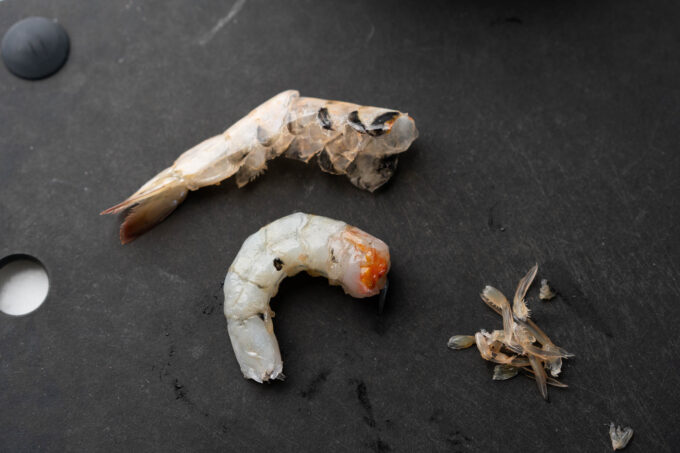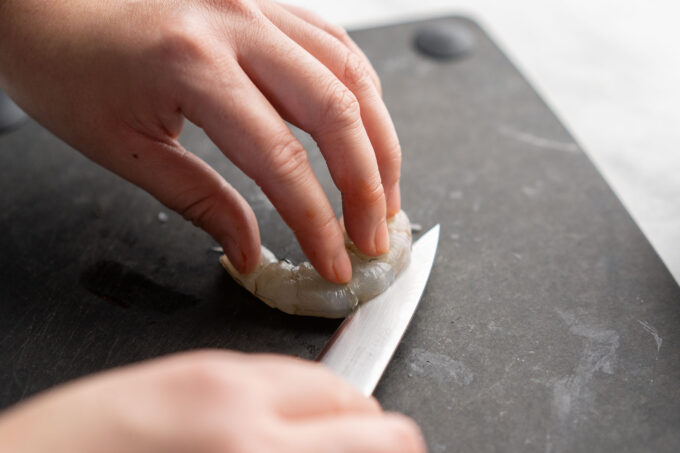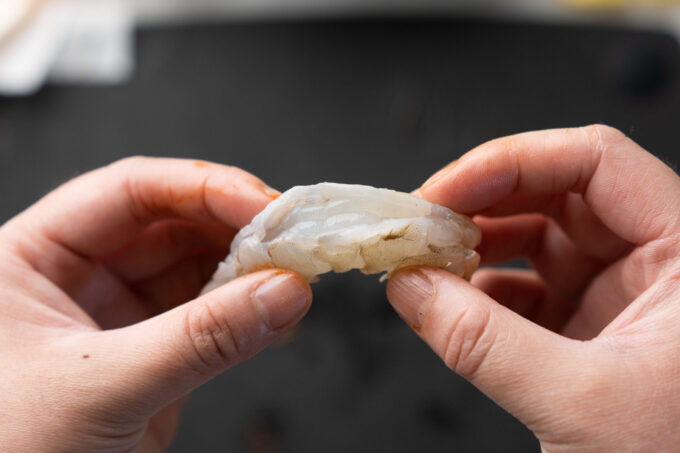Are you going to cook shrimp and want to know how to peel and devein them the right way? Some people might say you don’t even need to devein them, but we already know what we want to do, right?
You can clean shrimp quickly and devein them with or without shells. My mom taught me a really quick way to do it.
Deveining shrimp is an important step when preparing seafood, as it removes the digestive tract which can lend an unpleasant, gritty texture. But peeling off the shells can be time-consuming and lead to drier, less flavorful shrimp. So can you devein shrimp without fully peeling them? The answer is yes!
There are a couple easy methods to devein shrimp while leaving the shells on. This keeps moisture and flavors intact, while still getting rid of the vein In this guide, I’ll explain what the shrimp vein actually is, when it needs to be removed, and step-by-step techniques for deveining shrimp with the shells on
What is the Shrimp Vein?
The shrimp “vein” is not a vein at all – it’s the digestive tract that runs along the back of the shell. As bottom feeders, shrimp eat food and waste materials from the ocean floor that get processed into this tract. Leaving the vein in can lead to undesirable textures and flavors in a dish.
However, the vein is so named because it does look like a thin, dark vein when spotted through the translucent shrimp flesh. Peeling the shell is the easiest way to access and fully remove the entire vein. But for enhanced flavor and moisture, you can also devein shrimp without fully peeling them.
When is it Necessary to Devein Shrimp?
For the best taste and texture, it’s generally recommended to devein all but the smallest shrimp. Here are guidelines on when to devein:
-
Large shrimp – deveining is a must. The vein will be very gritty if left in.
-
Medium shrimp – devein for the best quality end result. Veins will likely be noticeable.
-
Small shrimp – deveining is optional. Small veins don’t impact texture or flavor much.
-
Using shrimp in soups, pasta, or saucy dishes – deveining is less important since flavors will be masked.
-
Eating shrimp plain, in cocktails, salads or lightly cooked – deveining is critical to avoid off tastes.
So in most cases, especially with larger shrimp, taking the time to devein them is worth the effort and minimal waste. Now let’s look at how to remove that unsavory vein while keeping the shell intact.
How to Devein Shrimp Without Peeling
You’ll need a sharp paring knife and either a toothpick or metal skewer. Here are two methods to try:
Split Cut Method
-
Using a paring knife, make a shallow cut along the length of the shrimp’s back shell. Don’t cut too deep.
-
Use the tip of the knife to make a lengthwise slit in the shell covering the vein.
-
Lift out and discard the vein through this slit. The shell remains on either side.
-
For thorough deveining, make additional shallow slits along the back as needed.
Toothpick Method
-
Insert a toothpick or thin skewer into the shrimp underside right beneath the vein.
-
Angle it diagonally through the shell segments on both sides of the vein.
-
Gently pull up the toothpick to lift out the vein.
-
Repeat down the length of the vein if it breaks apart during removal.
-
Discard the removed vein pieces.
Both methods allow you to devein shrimp without peeling off the shell completely. The split cut technique also lets seasonings and marinades penetrate better. The toothpick method minimally disturbs the shell. Choose your favorite!
Here are a few more tips for deveining shrimp with shells on:
-
Use a deveining tool for easier removal, especially when prepping lots of shrimp.
-
For marinated shrimp, cut shells so marinade can penetrate, then devein after marinating.
-
Remove vein just before cooking instead of in advance which can dry out the shrimp.
-
Rinse shrimp after deveining to eliminate any residue.
-
Butterfly and flatten shrimp after deveining for quicker, more even cooking.
Deveining shrimp is typically needed to remove the gritty, inedible digestive tract. But leaving the shells on helps retain moisture and shrimp flavor. With the proper technique, you can have the best of both worlds. Next time your recipe calls for shrimp, try this easy shell-on deveining method for the ideal texture and taste.

How to devein shrimp without shell (w/ a knife)
It’s easier to devein shrimp that don’t have shells because you don’t have to work with a hard shell. The easiest way to devein shrimp without shells is using a knife, and it’s the most common method.

1. After you’ve removed the head and shell, lay your shrimp on its side.

2. Depending on the size of the shrimp, make a shallow cut (about ⅛ to ¼-inch deep) along the back of the shrimp, from the tail to the head. The slit only needs to reach where the intestinal vein lives.

3. Remove the tract and clean the shrimp in a bowl of water or running water.
Is it necessary to devein shrimp?
I personally grew up eating cooked shrimp that wasn’t deveined, and I honestly couldn’t tell the difference. If you’re going to cook the shrimp and don’t mind the intestinal vein, you don’t have to take it out.
I typically don’t bother to devein smaller or medium-sized shrimp. Some chefs like to take the veins out of jumbo or large shrimp because the veins can be bigger and make the texture sandier or grittier. Also, take it off if you want to eat the shrimp raw for nigiri or sashimi so it doesn’t have a gritty texture or a bitter taste.
How to peel and De-vein shrimp with the Easy fork method.
Should you peel and devein shrimp?
Peeling and deveining shrimp can be a tedious process, but it’s not as bad as accidentally crunching into a shrimp shell while you’re trying to enjoy your seafood pasta. While it’s convenient to grab a bag of already deshelled, deveined shrimp at the supermarket, it’s the significantly pricier way to go.
Is shrimp ok on a soft diet?
Yes, you can, but as long as they are well cooked, and preferably cut into small pieces before eating. All very tender meats can go in.
Can you buy shrimp that’s already peeled & deveined?
Yes, you can buy shrimp that’s already peeled and deveined, but doing it yourself is simple and can save you money. Here’s what you’ll need: • a bowl of ice to keep the shrimp cold • a cutting board • a small paring knife • kitchen shears (optional) • a damp towel • a container for the shells
Can you eat a shrimp shell if it’s deveined or peeled?
1) Not deveined or peeled at all. The “vein” is the shrimp’s digestive tract and is perfectly safe to eat, but some prefer to remove it because it can be gritty and/or for aesthetics. And the shells are packed with flavor, which can infuse whatever dish you’re cooking with more crustacean flavor.
